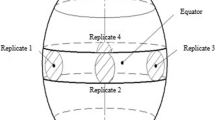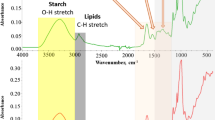Abstract
In order to rapidly and efficiently determine geographical origin and characterization categories in five varieties of black Goji berry (Lycium ruthenicum Murr.), near-infrared (NIR) spectroscopy and chemometrics were utilized for data acquisition. Using this data, synergy interval partial least squares (Si-PLS), linear discriminant analysis (LDA), K-nearest neighbors (KNN), back propagation artificial neural network (BP-ANN) and least-squares support vector machine (LS-SVM) regression were systematically evaluated and compared during model development. LS-SVM was initially performed to calibrate the discrimination model to identify the geographical origins and categories of the black Goji berry samples. Compared with other models, the recognition rate of LS-SVM was more than 98.18 %, which showed excellent generalization for identification results. Total anthocyanin content was closely related with the quality of black Goji berry. Synergy interval partial least squares (Si-PLS) was applied to develop the prediction model of total anthocyanin content. The model was optimized by a leave-one-out cross-validation, and model performance was evaluated by assessing the root mean square error of the prediction (RMSEP) and correlation coefficient (R t ) in the prediction set. Experimental results showed that the optimum results of the Si-PLS model were achieved as follows: RMSEP = 0.602 mg/g and R t = 0.899 in the prediction set. The overall results sufficiently demonstrate that spectroscopy coupled with the Si-PLS regression tool has the potential to successfully discriminate black Goji berry varieties.






Similar content being viewed by others
References
Abrahamsson C, Johansson J, Sparén A, Lindgren F (2003) Comparison of different variable selection methods conducted on NIR transmission measurements on intact tablets. Chemom Intell Lab Syst 69:3–12
Akhmadieva A, Zaichkina S, Ruzieva R, Ganassi E (1992) The protective action of a natural preparation of anthocyan (pelargonidin-3, 5-diglucoside). Radiobiologiia 33:433–435
Chaurasia OP, Singh B (1996–2001) Cold desert plants: Zanskar Valley. Cold desert plants Vol-I-V. Field Research Laboratory, Drdo
Chen C, Yun S, Tao Y, Mei L, Shu Q, Wang L (2013) Main anthocyanins compositions and corresponding H-ORAC assay for wild Lycium ruthenicum Murr. fruits from the Qaidam Basin. J Pharm Technol Drug Res 2:1
Dhar P, Tayade A, Ballabh B, Chaurasia O, Bhatt R, Srivastava R (2011) Lycium ruthenicum Murray: a less-explored but high-value medicinal plant from trans-Himalayan cold deserts of Ladakh. India Plant Archives 11:583–586
Ding X, Ni Y, Kokot S (2015) NIR spectroscopy and chemometrics for the discrimination of pure, powdered, purple sweet potatoes and their samples adulterated with the white sweet potato flour. Chemom Intell Lab Syst 144:17–l23
Haughey SA, Galvin-King P, Ho Y-C, Bell SE, Elliott CT (2015) The feasibility of using near infrared and Raman spectroscopic techniques to detect fraudulent adulteration of chili powders with Sudan dye. Food Control 48:75–83
Jia S et al (2016) Feasibility of analyzing frost-damaged and non-viable maize kernels based on near infrared spectroscopy and chemometrics. J Cereal Sci 69:145–150
Ji-yong S, Xiao-bo Z, Xiao-wei H, Jie-wen Z, Yanxiao L, Limin H, Jianchun Z (2013) Rapid detecting total acid content and classifying different types of vinegar based on near infrared spectroscopy and least-squares support vector machine. Food Chem 138:192–199
Kamei H, Kojima T, Hasegawa M, Koide T, Umeda T, Yukawa T, Terabe K (1995) Suppression of tumor cell growth by anthocyanins in vitro. Cancer Investig 13:590–594
Karaivanova M, Drenska D, Ovcharov R (1989) A modification of the toxic effects of platinum complexes with antocyans. Eksp Med Morfol 29:19–24
Kong J-M, Chia L-S, Goh N-K, Chia T-F, Brouillard R (2003) Analysis and biological activities of anthocyanins. Phytochemistry 64:923–933
Lai Y, Ni Y, Kokot S (2011) Discrimination of Rhizoma corydalis from two sources by near-infrared spectroscopy supported by the wavelet transform and least-squares support vector machine methods. Vib Spectrosc 56:154–160
Li B, Wei Y, Duan H, Xi L, Wu X (2012) Discrimination of the geographical origin of Codonopsis pilosula using near infrared diffuse reflection spectroscopy coupled with random forests and k-nearest neighbor methods. Vib Spectrosc 62:17–22
Lietti A, Cristoni A, Picci M (1975) Studies on Vaccinium myrtillus anthocyanosides. I Vasoprotective and antiinflammatory activity Arzneimittel-Forschung 26:829–832
Liu Z et al (2012) Genetic diversity of the endangered and medically important Lycium ruthenicum Murr. revealed by sequence-related amplified polymorphism (SRAP) markers. Biochem Syst Ecol 45:86–97
Lohumi S, Lee S, Lee W-H, Kim MS, Mo C, Bae H, Cho B-K (2014) Detection of starch adulteration in onion powder by FT-NIR and FT-IR spectroscopy. J Agric Food Chem 62:9246–9251
Marques AS, Castro JN, Costa FJ, Neto RM, Lima KM (2016) Near-infrared spectroscopy and variable selection techniques to discriminate Pseudomonas aeruginosa strains in clinical samples. Microchem J 124:306–310
Morazzoni P, Magistretti M (1986) Effects of Vaccinium myrtillus anthocyanosides on prostacyclin-like activity in rat arterial tissue. Fitoterapia 57:11–14
Muehlethaler C, Massonnet G, Esseiva P (2011) The application of chemometrics on infrared and Raman spectra as a tool for the forensic analysis of paints. Forensic Sci Int 209:173–182
Ni W et al (2013) Anti-fatigue activity of polysaccharides from the fruits of four Tibetan plateau indigenous medicinal plants. J Ethnopharmacol 150:529–535
Peng Q, Lv X, Xu Q, Li Y, Huang L, Du Y (2012) Isolation and structural characterization of the polysaccharide LRGP1 from Lycium ruthenicum. Carbohydr Polym 90:95–101
Prior RL et al (1998) Antioxidant capacity as influenced by total phenolic and anthocyanin content, maturity, and variety of Vaccinium species. J Agric Food Chem 46:2686–2693
Qingmei C, Guifa L, Dongzhu LPZ, Yuerong C, Zhenchang Z (1997) The study of Tibetan drug Lycium ruthenicium Murr in development and utilization. [J] Qinghai Science and Technology 1:004
Rice-Evans C, Miller N (1996) Antioxidant activities of flavonoids as bioactive components of food. Biochem Soc Trans 24:790–795
Suykens JA, De Brabanter J, Lukas L, Vandewalle J (2002) Weighted least squares support vector machines: robustness and sparse approximation. Neurocomputing 48:85–105
Tahir HE, Xiaobo Z, Tinting S, Jiyong S, Mariod AA (2016a) Near-infrared (NIR) spectroscopy for rapid measurement of antioxidant properties and discrimination of Sudanese honeys from different botanical origin. Food Anal Methods 9:2631–2641. doi:10.1007/s12161-016-0453-2
Tahir HE, Xiaobo Z, Xiaowei H, Jiyong S, Mariod AA (2016b) Discrimination of honeys using colorimetric sensor arrays, sensory analysis and gas chromatography techniques. Food Chem 206:37–43
Tamura H, Yamagami A (1994) Antioxidative activity of monoacylated anthocyanins isolated from Muscat Bailey A grape. J Agric Food Chem 42:1612–1615
Tanasković I, Golobocanin D, Miljević N (2012) Multivariate statistical analysis of hydrochemical and radiological data of Serbian spa waters. J Geochem Explor 112:226–234
Teye E, Huang X, Dai H, Chen Q (2013) Rapid differentiation of Ghana cocoa beans by FT-NIR spectroscopy coupled with multivariate classification. Spectrochim Acta A Mol Biomol Spectrosc 114:183–189
Teye E, Huang X-y, Lei W, Dai H (2014) Feasibility study on the use of Fourier transform near-infrared spectroscopy together with chemometrics to discriminate and quantify adulteration in cocoa beans. Food Res Int 55:288–293
Tingting S, Xiaobo Z, Jiyong S, Zhihua L, Xiaowei H, Yiwei X, Wu C (2016) Determination geographical origin and flavonoids content of Goji berry using near-infrared spectroscopy and chemometrics. Food Anal Methods 9:68–79
Wang H, Cao G, Prior RL (1997) Oxygen radical absorbing capacity of anthocyanins. J Agric Food Chem 45:304–309
Wang Y, Mei M, Ni Y, Kokot S (2014) Combined NIR/MIR analysis: a novel method for the classification of complex substances such as Illicium verum Hook. F. and its adulterants. Spectrochim Acta A Mol Biomol Spectrosc 130:539–545
Wu D, Sun D-W, He Y (2012) Application of long-wave near infrared hyperspectral imaging for measurement of color distribution in salmon fillet. Innovative Food Sci Emerg Technol 16:361–372
Xiaobo Z, Jiewen Z, Yanxiao L (2007) Apple color grading based on organization feature parameters. Pattern Recogn Lett 28:2046–2053
Xiaobo Z, Jiewen Z, Holmes M, Hanpin M, Jiyong S, Xiaopin Y, Yanxiao L (2010a) Independent component analysis in information extraction from visible/near-infrared hyperspectral imaging data of cucumber leaves. Chemom Intell Lab Syst 104:265–270
Xiaobo Z, Jiewen Z, Povey MJW, Holmes M, Hanpin M (2010b) Variables selection methods in near-infrared spectroscopy. Anal Chim Acta 667:14–32
Xiaowei H, Xiaobo Z, Jiewen Z, Jiyong S, Xiaolei Z, Holmes M (2014) Measurement of total anthocyanins content in flowering tea using near infrared spectroscopy combined with ant colony optimization models. Food Chem 164:536–543
Zhang H, Li X, Wang J, Yang Y (2007a) The structure characteristic of the plant community in the lower reaches of Tarim River. Ecology & Environment 16:1219–1224
Zhang J et al (2007b) Comparison of anthocyanins in non-blotches and blotches of the petals of Xibei tree peony. Sci Hortic 114:104–111
Zheng J et al (2011) Anthocyanins composition and antioxidant activity of wild Lycium ruthenicum Murr. from Qinghai-Tibet Plateau. Food Chem 126:859–865
Zou X, Zhao J, Li Y (2007) Selection of the efficient wavelength regions in FT-NIR spectroscopy for determination of SSC of ‘Fuji’ apple based on BiPLS and FiPLS models. Vib Spectrosc 44:220–227
Author information
Authors and Affiliations
Corresponding author
Ethics declarations
Ethical Approval
This article does not contain any studies with human participants or animals performed by any of the authors.
Conflict of Interest
Li Yahui declares that she has no conflict of interest. Zou Xiaobo declares that he has no conflict of interest. Shen Tingting declares that she has no conflict of interest. Shi Jiyong declares that he has no conflict of interest. Zhao Jiewen declares that she has no conflict of interest. Mel Holmes declares that she has no conflict of interest.
Informed Consent
Not applicable
Funding
The authors gratefully acknowledge the financial support provided by the National Science and Technology Support Program (2015BAD17B04, 2015BAD19B03), the National Natural Science Foundation of China (Grant No. 61301239), the Natural Science Doundation of Jiangsu Province (BK20130505), Jiangsu international cooperation project (BZ2016013), Suzhou Science and Technology Project (SNG201503), Zhenjiang International Cooperation Project (GJ2015010) and Priority Academic Program Development of Jiangsu Higher Education Institutions (PAPD).
Rights and permissions
About this article
Cite this article
Yahui, L., Xiaobo, Z., Tingting, S. et al. Determination of Geographical Origin and Anthocyanin Content of Black Goji Berry (Lycium ruthenicum Murr.) Using Near-Infrared Spectroscopy and Chemometrics. Food Anal. Methods 10, 1034–1044 (2017). https://doi.org/10.1007/s12161-016-0666-4
Received:
Accepted:
Published:
Issue Date:
DOI: https://doi.org/10.1007/s12161-016-0666-4




